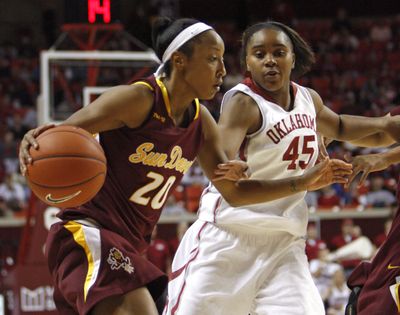GSL a D-I hotbed
College coaches from all levels harvest area talent

Two Lewis and Clark girls signed letters of intent last month to play Division I basketball, bringing the number of top-notch Tigers going to D-I to seven spread over five seasons.
It’s no wonder LC has three straight State 4A titles, preceded by a third-place finish.
The Tigers’ bounty, though, is just a nice slice of the Greater Spokane League pie.
College coaches – including many from lower divisions – harvest plenty of talent from the GSL. More than 60 players went from the GSL to D-I programs in the last 20 years, and that number swells when adding nearby leagues in Washington and Idaho.
Gonzaga coach Kelly Graves began recruiting area players when he started coaching at Big Bend Community College in 1989, and in his nine years at GU has had more than a half-dozen local athletes.
“I think it’s unique to this area and I’ve been smart enough to recruit it since I was a rookie,” he said. “There are several reasons. One is it’s important here – you guys cover it … It’s part of our culture. Two, there are good coaches here. And three, women’s basketball is still a suburban and rural game. I think the men’s game is more inner-city. That’s just my opinion.”
LC’s line of talent isn’t even the longest, considering D-I scholarships only.
Starting with current Mead coach Regan Freuen Drew going to Stanford in 1994, the Panthers had a D-I player every year through 2003, when Adrianne Ferguson went to WSU.
Looking back, the numbers are staggering.
Starting with Shadle Park’s back-to-back state championships (1988 and ‘89, with LC picking up a second and third) the GSL has won 11 titles and has had a trophy team every year, collecting 37 in all.
“One of the things I think is (Spokane) is a community that is relatively isolated and I think those kinds of communities can be very supportive of their athletics,” said Jim Sollars, former Wenatchee Valley Community College and Portland State coach.
The GSL has had a D-I player for at least 23 straight years. Many more go to smaller schools and some become D-I players after starting at a junior college.
“Obviously, it’s a combination of a lot of things,” said Mike Arte, the head coach at Gonzaga Prep for 21 years. “One is the support we get from the community, AAU and parents. Another is the support from the league. We’re treated equally. And the coaches work hard and they’re quality coaches.
“Another thing I’ve found, too, is the coaches get along so there is a sharing of things that make us all better.”
“People didn’t realize the talent pool until we see their success in the college ranks,” Tigers coach Jim Redmon said of the GSL in general and LC in particular. “Good genes. Honestly, we’ve had a great parent group. They did the right things with the kids at younger ages. They had good coaching in (club) programs. There has been a huge influence by different coaches at different times.”
The LC string started with Briann January in the November 2004 signing class. She was followed by Heather Bowman (Gonzaga), then Katelan Redmon (Washington, now Gonzaga) and Lyndi Seidensticker (Montana State), and last year Brittany Kennedy (Oregon State). The signed seniors are Jeneva Anderson (UW) and Sarah Kliewer (Portland).
During the LC string, nine other GSL players have gone D-I.
The high-water mark was in 2006-07, when LC beat University for the state title and Mead was fourth. University’s Angie Bjorklund, who signed with national power Tennessee, highlighted a senior class that included Redmon, Seidensticker, Lexi Bishop of Shadle Park (Portland State), Kelli Valentine of Mead (PSU), Tara Cronin of G-Prep (Portland), and Jenna Galloway of Ferris (Northern Arizona).
Central Valley has had success that matches LC.
But Mead is still the gold standard for teams and talent.
The Panthers won state in 1990, ’92 and ’96. They were second in 1991, third in ’94, fourth in ’93 and fifth in ’95. That’s a record of 24-4 in state tournament games.
“Looking back over 20 some years, Shadle Park of the ’80s, Mead and CV of ’90s and LC of 2000s, they’ve all made us get better,” Arte said. “Even middle-of-the-pack teams in the GSL are very good. If you go to another league, you won’t find that quality. All those good programs have made us all work harder.”
The GSL isn’t carrying the torch for women’s basketball by itself. Area schools, including North Idaho, have sent an impressive array of talent forward.
“This is a basketball haven,” said Ron Adams, director of the Spokane Stars club program. “How else do you explain it?”